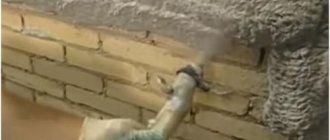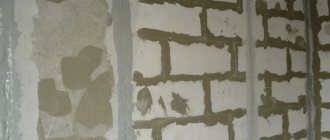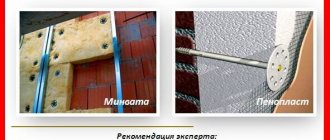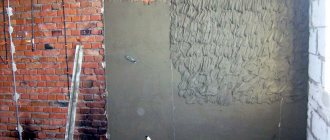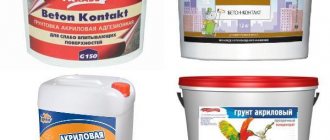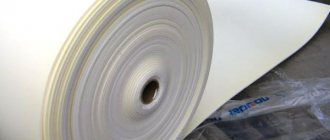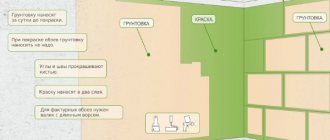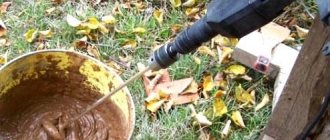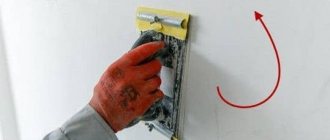Polystyrene foam is a foam material, it is distinguished by its porous structure and low weight. These properties limit the use of protective mixtures: not all types of putty are suitable for finishing such slabs. In addition, you need to take into account the operating conditions of the foam: different recommendations for finishing finishing work are given outdoors and indoors.
Is it possible to apply putty to foam insulation?
Lightweight slabs will not withstand the effects of a layer of protective mixture if they are secured only with an adhesive. It is recommended to use putty for applying to the foam, provided that it is additionally secured with mushroom-shaped dowels. In this case, an adhesive composition must also be used.
The two-stage fastening method increases the resistance of the material to mechanical loads. Mushroom caps at various points around the perimeter and center of the slab increase the strength of the coating. This fastening method allows the foam to better withstand external factors (for example, wind load, etc.).
A layer of putty makes the slabs heavier. A dowel with a mushroom cap eliminates this drawback. As a result, it becomes possible to carry out finishing on the thermal insulation layer.
But polystyrene foam has disadvantages. One of them is low resistance to aggressive environments, especially solvents. For example, the insulation should not be allowed to come into contact with benzene, acetone, dichloroethane, etc.
Accordingly, the putty should not contain solvents, as well as any other components that will corrode the foam. Otherwise, the use of such a product will lead to rapid destruction of the coating.
To understand which putty is suitable for polystyrene foam, it is recommended to study the information on the label. The manufacturer indicates if the mixture can be used for finishing foam materials.
Is it possible to plaster polystyrene foam and why is it done?
Polystyrene foam is popular not only because of its low cost, but also because it can retain its performance properties for a long time. It is not afraid of temperature changes and easily interacts with precipitation.
But with regular interaction with the environment, the process of destruction of the structure begins, as the material dries out. Therefore, plastering foam plastic will help solve a number of the following problematic issues:
- Protection. An additional outer layer is created, which will be the first to take on all mechanical damage. The plaster will also act as a barrier to the destructive effects of ultraviolet radiation.
- Obstacle to moisture. Despite the fact that polystyrene foam is not afraid of water, it takes a long time to dry. In addition, dampness significantly lowers the thermal insulation threshold and makes it more fragile.
- Increases the level of fire safety. Modern plaster has such a composition that in the event of a fire it will not become “food” for fire, which means that the fire will not spread.
Creating the final drawing
All these issues can be easily resolved by plastering the foam. But you must first decide on the mixture in order to get the proper result.
Advantages of this procedure
Foam boards can be used on objects for various purposes, indoors and outdoors. This means that operating conditions are always different. For this reason, when choosing a finishing method, the positive qualities of different options are taken into account, which will allow you to choose the right one.
Advantages of puttying:
- Provides protection from ultraviolet radiation. When exposed to the sun for a long time, polystyrene gradually loses its properties and begins to deteriorate: it crumbles, turns yellow, and at the same time the thermal insulation qualities of the coating deteriorate.
- Strengthening. Foamed material of this type is subject to dynamic and static loads, so it will quickly become unusable when used without a protective layer. And if the integrity is damaged, the thermal insulation properties also deteriorate, which means that the surface must be puttied.
- Reduces the risk of fire. Polystyrene foam is flammable, and during the process it releases toxic substances, so it cannot be used without protection. In this case, putty is used; modern compositions of this type most often contain fire retardant additives.
- Moisture protection. Such a plate is not hygroscopic only upon short-term contact with water, but if it is in a humid environment for a long time, it gradually absorbs liquid, and such material takes a long time to dry. Foam putty will help prevent such troubles.
- Improving the appearance of the thermal insulation layer. If you leave the slabs unfinished, the façade of the building will look unattractive. The putty mixture also solves this problem: it allows you to create a rough base for subsequent finishing with other materials.
Why do you need to trim the foam?
Puttying polystyrene foam is a prerequisite in the process of insulating a room with this material. But, auxiliary finishing of polystyrene foam surfaces is not always used. It all depends on the method of attaching the insulation. If the foam is attached to the wall using construction umbrellas and glue, then puttying is used. Other fastening methods completely exclude this finishing method.
The foam itself is very fragile, so it needs additional protection, which can be achieved using special finishing mixtures - primers and putties.
Finishing materials in this direction are necessary for:
- reducing the risk of mechanical damage;
- minimizing exposure to moisture;
- hiding foam from exposure to direct ultraviolet rays;
- improving the aesthetic appearance of insulating material;
- formation of an adhesive base between all layers of finishing;
- smoothing out temperature differences.
The primer is the fastening link between the surface of the foam and further layers of the finishing coating. Puttying is necessary in order to eliminate defects in the surface of the foam and prepare it for painting or decorative plaster.
On video: how to insulate a house with polystyrene foam.
How to glue ceiling tiles and seal seams
For interior work, mixtures with appropriate characteristics are selected. This takes into account the area of application of the putty and its structure. Even the method of mixing the solution plays a role: you can purchase dry mixtures or ready-to-use materials. The first option is cheaper, but the second has more advantages.
Thus, the finished putty for polystyrene foam is distinguished by sufficient viscosity and uniform consistency, which improves the quality of adhesion and increases the service life of the coating.
For comparison, when preparing the mixture yourself, the proportions of the components can be changed. This will lead to the loss of properties of the material. As a result, its adhesion and strength characteristics will be lost.
Different types of putty are used for various jobs:
- Filling gaps between tiles: a finishing compound is suitable. This allows you to create a smooth surface, thereby improving the external qualities of the finishing layer.
- Installation of ceiling slabs. It is recommended to use acrylic putty; it is distinguished by high viscosity, which will ensure improved adhesion of materials. In addition, the acrylic mixture allows you to complete the work quickly, and excess can be removed with a rag or sponge soaked in water.
What does puttying do?
Foam putty will not only improve the quality of the subsequent finishing, but will also provide the following:
- Strengthening. The material breaks easily under mechanical stress, for example, an unsightly hole can form upon impact. The putty protects against such influences.
- Preservation of thermal insulation qualities. Moisture is not dangerous for penoplex, but due to the low vapor permeability of the material, trapped moisture particles from the foam structure take a long time to be removed, which has a bad effect on the ability to retain heat.
- Increasing fire retardant qualities. Expanded polystyrene is very flammable, and the applied putty will serve as an additional way to reduce the risk of fire.
- Protection from wind and sun. Even if interior decoration is carried out, it is impossible to completely avoid exposure to sunlight on the material, and they have a destructive effect on the foam structure.
But how to choose a putty solution so that it has maximum protective qualities?
How to prepare materials and tools
First, putty is selected using polystyrene foam. The best option is a universal mixture or a special composition for working on the surface of foam material. Finishing putty is also prepared. When choosing a composition, take into account the area of its application: indoors, outdoors (on the facade). The type of components is examined to eliminate the risk of using mixtures containing solvents.
You will also need other materials:
- reinforcing mesh (for work on the facade);
- polyurethane foam;
- primer mixture;
- adhesive composition (determine a suitable option taking into account the type of foam boards);
- decorative material for finishing.
In addition, all the necessary tools are immediately prepared for work:
- container for mixing components (if dry putty is purchased);
- roulette;
- roller;
- spatulas of various sizes and with different types of edges (serrated, smooth);
- corners for processing corner areas of the room;
- grater (used to increase the roughness of the foam and remove defects from the surface);
- sharp knife;
- sandpaper;
- drill with a “construction mixer” attachment.
Preparatory work
In addition to the correct choice of finishing material, it is necessary to make appropriate preparations for work: collect the necessary tools and prepare mixtures and products. Preliminary cleaning of the wall is also necessary.
First you need to collect all the necessary equipment:
- reinforcing mesh made of plastic or metal;
- dry putty;
- a certain type of primer;
- wide and narrow spatulas;
- construction mixer for preparing the mixture;
- roller and paint brushes;
- construction float with clamps.
First, the wall surface is prepared for attaching foam blocks or sheets. After installation of expanded polystyrene, a primary primer is performed. This procedure will eliminate the appearance of mold and mildew in the thickness of the finishing material and increase the adhesion of the finishing materials. Afterwards plastering is carried out using reinforcing mesh. And only after that they do the puttying.
DIY puttying instructions
Preparation before applying a protective layer over the foam:
- Check the quality of the base (foam material slabs), how firmly they hold.
- Clean the surface from dirt.
- Use a grater to remove defects (protruding parts of the slabs).
- The mushroom caps of the dowels are hidden. They need to be “drowned” a little into the foam.
- Fill the joints and recesses in the area where the fasteners are located with a leveling mixture.
- Fix reinforcing corners at wall joints and window slopes.
- Prime the surface of the foam.
Depending on the method of decorative finishing, the technology for applying the protective layer changes.
For example, if the coating is heavy, you need to decide how to putty the foam in such a way as to increase the strength of the structure. For this purpose, a reinforcing mesh is used - its density is 140-160 g/m².
Installation instructions:
- The material is cut to improve the ease of use. Moreover, you need to provide a 10 cm margin on each side in order to lay the pieces of mesh overlapping.
- Installation begins with slopes. In this case, a leveling layer of 3-4 mm of putty is applied, then the reinforcement is placed and pressed in.
- Continue strengthening the foam surface on the remaining sections of the walls.
- Use a spatula to level the coating.
The putty is rubbed down to increase the adhesion of materials in the future. When the composition dries, apply another 1 layer - 3 mm. It is also rubbed, but with the aim of increasing the smoothness of the surface.
For painting
It is necessary to carefully level the surface, otherwise all small defects will be visible. After applying the putty for polystyrene foam, treat the surface twice with a special primer (use a roller, preferably one with short pile). Apply the finishing composition. Then the surface is sanded. Painting is carried out after dust removal.
On the street
You need to decide how to putty the foam. The best option is facade putty (adhesive based). This will ensure high-quality adhesion and increase the service life of the thermal insulation “pie” made of foam plastic and other materials. After the putty has hardened, finishing is performed. If decorative plaster is used, primer with a granular structure is purchased.
Indoors
In this case, there is no need to further strengthen the structure with reinforcement. You can use glue. The most suitable type of putty for protecting foam plastic is a universal cement mixture. When the layer of material has dried, proceed to grouting (leveling). At the last stage, decorative finishing is performed.
We mount the mesh on polystyrene foam
Thanks to the reinforcing mounting mesh, the putty will not crack, and the surface itself will become stronger. There is no way to skip this stage. The step-by-step instructions for gluing the mesh are as follows:
- The fiberglass mesh is prepared for gluing. Use a knife to cut it into pieces of the required size. When finishing the facade, the mesh is also prepared for the slope. It is important to note that the edges of the mesh should overlap each other by about 10 cm. The gap at the corners is also 10 cm.
- The mesh will be glued to the adhesive. It will have to be cooked. The packaging contains instructions on how to do this. Typically the process is as follows: the dry mixture is added to a clean container, after which water is poured into it. The contents are mixed. During the kneading process, additional water is added to obtain a homogeneous composition. It should resemble dough in consistency. All you have to do is wait 7-10 minutes and move the contents again.
- Gluing the mesh begins with the slopes. To do this, you need to scoop up the glue with a narrow spatula onto a wide one, and transfer it to the slope, maintaining a layer of 5 mm. Next, a piece of mesh is applied to the surface with the adhesive composition, leveled and embedded in the solution with a spatula. Everything should turn out smooth and even.
Already at this stage, you should ensure that the surface is leveled, maneuvering the spatula smoothly and evenly. When the slopes are processed, you can proceed to the entire surface of the wall. The task is the same: apply a 5 mm layer to the surface, apply the mounting mesh and embed it with a spatula. In this case, it is important to ensure that there is a 10 cm overlap at the joints and leave a 10 cm fold at the corners. How exactly to handle the corners can be seen in this photo. For this purpose you will need to have a coal spatula.
That's all, the mesh is glued and the surface is ready for the next stage. After all, the wall is still far from ideal. Now we will try to make it as it should be.
Expert advice
When deciding whether it is possible to putty polystyrene foam, turn to experienced craftsmen.
In this case, recommendations are given for working with such slabs:
- given the smooth surface of the foam, it is better to choose a putty containing glue;
- you should purchase a composition that was released recently: the longer the putty is stored, the faster it loses its properties;
- the primer composition can be replaced with PVA glue (twice treatment is sufficient);
- when working with reinforcing mesh, the putty consumption will be 3 kg/m², but if you need to level the surface, the amount of the mixture increases to 5 kg/m².
It is not recommended to attach heavy decorative material to foam plastic. However, finishing with paint or plaster is acceptable. The preliminary rough base is protected with putty.
How to putty foam
Puttying penoplex differs from processing other materials. This is due to the peculiarity of the structure of polystyrene foam.
The first thing you need to do is apply the reinforced mesh before puttingty. For internal surfaces this is not as necessary as for external ones, but it is desirable.
Without reinforced mesh, the repair will be of poor quality, especially on external surfaces.
After all, under the influence of the sun, wind and temperature changes, the putty on the foam can peel off, crack and deform, which will significantly deteriorate the quality of the work done.
Surface preparation
For preparatory work you will need to adhere to the following rules:
- The first thing you need to pay attention to is the finishing surface - whether it is being treated for the first time or repeatedly. If you do it again, you need to clean it from dirt, dust and other small particles. If there is already a reinforcing mesh installed, then there is no need to remove it.
- Next, primer work is carried out. To do this, it is necessary to take mixtures that do not contain chemically aggressive substances, since polystyrene foam is a capricious material. The primer must be carried out with deep penetration mixtures. PVA glue diluted with water in a 1:1 ratio is best suited for this.
- After the primer, a mesh is glued, cut into strips along the long walls. This is done when the primer has dried well. Tile adhesive is best for gluing the mesh.
Application
Then puttying is carried out according to the following algorithm:
- The first ball of putty is applied as a thin ball onto the mesh. The less putty, the better the quality of finishing work. The initial putty gives strong adhesion to the exterior.
- When the putty layer has dried, you need to re-prime it, which will give better quality to the putty work.
- The following layers of putty are applied to level the surface and hide traces of the mesh. To improve strength, a primer must be applied between applying the putty mixture.
